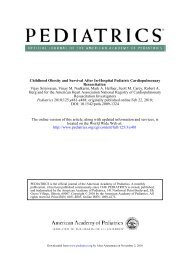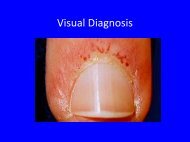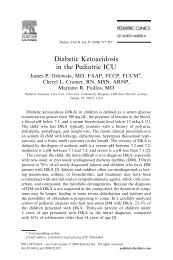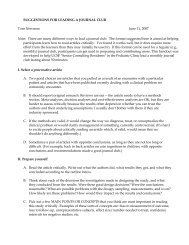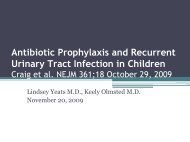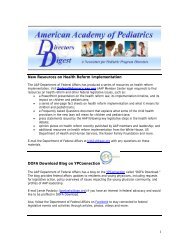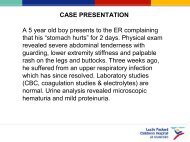Urinary tract Infection - Pediatrics House Staff
Urinary tract Infection - Pediatrics House Staff
Urinary tract Infection - Pediatrics House Staff
You also want an ePaper? Increase the reach of your titles
YUMPU automatically turns print PDFs into web optimized ePapers that Google loves.
<strong>Urinary</strong> Tract <strong>Infection</strong>s<br />
Lucile Packard Children’s Hospital<br />
Pediatric Residency Training Program<br />
Renal Learning Topics for Residents<br />
Scott Sutherland, MD<br />
CASE PRESENTATION, CLINICAL QUESTIONS, AND BOARDS STYLE QUESTIONS<br />
A 5 month old girl comes to your urgent visit clinic with a two day history of fever and a one day<br />
history of vomiting. She has no diarrhea or URI symptoms but has significantly decreased intake<br />
of both solids and liquids. She has no significant medical history, is currently receiving ibuprofen<br />
for the fever, has no known drug allergies, and has received all scheduled immunizations. She is<br />
an only child who lives at home with her mother and father. There is no significant family history.<br />
On examination, she has the following vital signs: temperature of 102.8°F, heart rate of 145,<br />
respiratory rate 28, oxygen saturation 99%. Her examination is unremarkable and you are unable<br />
to locate a source for her fever.<br />
Question 1: Should this child have urine studies performed?<br />
Answer 1: This child should be evaluated for a urinary <strong>tract</strong> infection. UTIs are now the most<br />
common occult infection in febrile infants without a source, especially in those who have been<br />
fully immunized. In general, UTIs in infants are accompanied by nonspecific signs/symptoms.<br />
Although in the literature vomiting has not been correlated with the presence of a UTI, in practice,<br />
it is a common nonspecific symptom. Other presenting symptoms include decreased oral intake,<br />
irritability, and in infants less than one month, hyperbilirubinemia. Older children often are able to<br />
localize, and can complain of dysuria, abdominal pain, or flank pain.<br />
There is debate as to which children should be evaluated for UTIs. Suggested approaches range<br />
from fairly simple to quite complex. The AAP “Practice Parameter: The Diagnosis, Treatment,<br />
and Evaluation of the Initial <strong>Urinary</strong> Tract <strong>Infection</strong> in Febrile Infants and Young Children”<br />
from 1999 basically suggests that any child under the age of two with an unexplained fever should<br />
be evaluated for a UTI. By comparison, the JAMA article entitled, “Does This Child Have a<br />
<strong>Urinary</strong> Tract <strong>Infection</strong>” from 2007, takes an extreme scientific approach by applying likelihood<br />
ratios for each presenting symptom, sign, or demographic characteristic to baseline prevalence<br />
data. This article is fascinating and worth a read if only to see how they move stepwise through a<br />
practice case. However, as interesting as it is academically, it is hard to apply strictly in practice.<br />
It is probably best used to identify some of the more important risk factors for UTIs which can be<br />
used in the clinical setting. Although not absolute, here are some general guidelines for deciding<br />
which febrile children to evaluate for UTIs:<br />
● Pretty much any non-verbal child (2y they probably should have 2 of the following:<br />
-Abdominal pain, dysuria, temp >39C, increased urinary frequency, new<br />
incontinence, vomiting<br />
● If >2 and circumsized, they probably should have 3 or more of the above findings<br />
●Any child with a history of UTI
●Any child with a history of any urologic abnormalities<br />
However, remember: If you find yourself wondering whether or not you should check urine<br />
studies, you probably should.<br />
Question 2: True or False? UTIs are more common in girls.<br />
Answer 2: This is a tough question to answer. Most of the time, the answer would be true.<br />
Between birth and 12 years of age the incidence of UTIs in boys and girls are 1.3% and 3.7%,<br />
respectively. During school age, UTIs are about 3 times more common in girls than in boys and in<br />
adolescence UTIs are far more common in girls than boys. However, under the age of 1, UTIs are<br />
seen more frequently in boys than girls – the ratio is approximately 3-5:1. UTIs are much more<br />
common in uncircumsized boys than circumsized boys.<br />
Question 3: Which urine studies should be obtained?<br />
Answer 3: The diagnosis of a UTI requires both a urinalysis WITH microscopy (microscopic<br />
examination of urine for RBCs, WBCs, and bacteria) and a urine culture. Up to 20% of children<br />
with a UTI will have a normal urinalysis. Additionally, there is a marked false positive rate<br />
associated with urinalysis. A culture is the gold standard for diagnosis and a mandatory test. It<br />
allows you to identify the bacterial pathogen if present, and provides sensitivity data for<br />
antibiotics.<br />
A more complex issue is how to obtain the urine. Truly, a catheterized specimen (or suprapubic<br />
aspirate) is the gold standard technique and any young child who is ill appearing should have urine<br />
obtained by catheterization. Suprapubic aspiration , at least locally, is an uncommonly performed<br />
procedure; additionally it really requires ultrasound guidance. A bagged urine culture is helpful if<br />
it is negative, however, up to 85% of positive cultures from bagged urines are false positives.<br />
Some practice guidelines suggest obtaining a bagged u/a and catheterizing for a culture only if the<br />
u/a looks concerning. This approach is not wholly unreasonable. Older children can have urine<br />
obtained by clean catch midstream collection.<br />
You decide to obtain a urinalysis and culture via urethral catheterization. The urinalysis is<br />
significant for a specific gravity of 1.050, a pH of 6.5, negative blood and protein, 3+ leukocyte<br />
esterase, negative nitrites, 20-30 WBCs per HPF, and 0-5 RBCs per HPF.<br />
Question 4: What do you make of the u/a?<br />
Answer 4: The u/a provides much information, but the most pertinent parameters associated with<br />
UTIs are leukocyte esterase, nitrite, and the presence of pyuria and bacteturia. Some physicians<br />
will wax poetically about the “Gram Stain of an Unspun Urine Sample.” This is truly the best early<br />
detection tool, with a sensitivity and specificity of 93% and 95%, respectively. However, this test<br />
requires technical expertise and is time consuming, and therefore infrequently performed by<br />
laboratories.
The sensitivities and specificities of the tests on the u/a are as follows:<br />
Test Sensitivity Specificity<br />
LE 84% 78%<br />
Nitrite 50% 98%<br />
Both 72% 96%<br />
Pyuria 77% 89%<br />
Bacteria (gram stain) 93% 95% (lower if centrifuged)<br />
Both 85% 99.9%<br />
Based on a meta-analysis (10 studies), in kids less than 5y the UTI likelihood ratios for LE and<br />
nitrites are as follows:<br />
- Negative dip LR 0.2<br />
- Pos LE OR Nitrite LR 6.1<br />
- Pos LE AND Nitrite LR 28<br />
Question 5: What is your preliminary diagnosis?<br />
Answer 5: This child probably has pyelonephritis. The term “UTI” is a general term for an<br />
infection anywhere along the urinary <strong>tract</strong>. The term “cystitis” suggests localized bladder infection<br />
and the term “pyelonephritis” suggests spread of the infection into the renal parenchyma.<br />
Differentiation between the two diagnoses is important because pyelonephritis is associated with a<br />
risk of renal scarring. In older, verbal children, the diagnosis of pyelonephritis is based on<br />
symptoms such as back pain or severe abdominal pain as well as signs such as costovertebral angle<br />
tenderness. However, in younger children the diagnosis is more challenging and any child with a<br />
febrile UTI should be assumed to have pyelonephritis and managed as such.<br />
Question 6: How should this child be managed? Does she require admission? Can oral<br />
antibiotics be used?<br />
Answer 6: One of the landmark papers on the subject of UTIs is “Oral versus initial intravenous<br />
therapy for urinary <strong>tract</strong> infections in young febrile children,” which was published in<br />
<strong>Pediatrics</strong> in 1999. This article demonstrated that it was feasible to treat young children with<br />
febrile UTIs as outpatients using oral antibiotics. They randomized 306 kids between the ages of 1-<br />
24 months to either oral cefixime (3 rd generation cephalosporin) or IV cefotaxime. Oral antibiotics<br />
were equally effective; there was an equivalent time to defervescence, no increase in symptomatic<br />
reinfection, and no increase in renal scarring. While this is an important paper that changed<br />
practice, it is important to realize that it did have limitations. First, they excluded all children with<br />
a previous UTI or urologic abnormality. Second, each child randomized to oral, outpatient therapy<br />
received a witnessed DOUBLE dose of cefixime in the ER. Third, children under the age of 2mo<br />
who were randomized to the oral arm were ADMITTED and given the cefixime under supervision<br />
of hospital staff. Furthermore, children with vomiting were ADMITTED, given IV fluids, and<br />
administered the cefixime under supervision as well. Hmm, are you still sure that you want to
discharge that 3 month old with vomiting and a UTI? The point here is that if you are going to<br />
manage a young child with a febrile UTI as an outpatient, you should make sure the child is low<br />
risk and you need to guarantee exceptional follow up. If you cannot do so, hospitalization is the<br />
safest option. Additionally, if you are going to use oral antibiotics, you should not use keflex. 80-<br />
90% of UTIs are caused by E Coli; nearly 40% of E. Coli recovered from the urine here at LPCH<br />
are resistant to cephalexin. Amoxicillin is an equally poor choice as >50% of E. Coli are resistant<br />
to amoxicillin. Instead you should prescribe an oral 3 rd generation cephalosporin. Your most<br />
common choices are likely to be cefixime (Suprax), cefdinir (Omnicef), or cefpodoxime (Vantin).<br />
The treatment course for pyelonephritis is 14 days. Uncomplicated UTIs in children can be treated<br />
for 10 days.<br />
You should hospitalize children:<br />
● Less than 3-6 months of age (some would argue less than 12 months of age).<br />
● With a clinical concern for bacteremia/urosepsis (ill appearing).<br />
● Who are immunocompromised.<br />
● Who cannot tolerate the oral medication.<br />
● With any degree of renal insufficiency.<br />
● With any urologic abnormality.<br />
An alternative plan that can be used in children managed as outpatients is to administer ceftriaxone<br />
in the ED prior to discharge. The child then follows up with his/her pediatrician or the ED the next<br />
day to get a second dose of ceftriaxone. Then, the child returns again on the 3 rd day when culture<br />
and sensitivity results are available. If the child appears to be improving, you can transition onto<br />
an appropriate oral antibiotic. You need fairly compliant parents for this plan, though.<br />
You diagnose the child with a febrile UTI and suspect she has pyelonephritis. Given the child’s<br />
age and vomiting, as well as your concern regarding follow up, you decide to admit this girl for<br />
parenteral antibiotic therapy. You start the child on ceftriaxone since a dose had already been<br />
administered in the ED. The urine culture grows 55,000 CFU/mL of Escherichia coli 24 hours<br />
after admission.<br />
Question 7: Do you agree with this choice of antibiotics?<br />
Answer 7: Therapy for UTIs, regardless of whether or not the child is admitted, need to be<br />
empiric. Treatment needs to start immediately and it is not reasonable to await culture results. 3 rd<br />
generation cephalosporins are good choices once the child is admitted. If the child is receiving<br />
UTI prophylaxis, has received antibiotics in the past for UTIs, or has urologic abnormalities, you<br />
should at least consider broader spectrum agents. Children who are admitted should receive IV<br />
antibiotics until they have been afebrile for 24-48 hours and can tolerate oral administration of a<br />
comparable antibiotic.<br />
Question 8: Does the culture confirm your original diagnosis?<br />
Answer 8: Yes. Any urine culture obtained by catheterization that grows >10,000 CFU/mL of a<br />
single, true urinary pathogen should be considered positive. Some other centers use a higher cutoff
of 50,000 CFU/mL. If the culture is obtained by a bag or is a clean catch sample, the cutoff is<br />
100,000 CFU/mL. Any growth in a culture obtained by suprapubic aspirate should be considered<br />
positive.<br />
Question 9: Which of the following imaging studies should be obtained in this child?<br />
A. 1 and 2<br />
B. 2 and 4<br />
C. 1, 2, and 4<br />
D. 3 and 5<br />
1. Dimercaptosuccinic acid scan (DMSA)<br />
2. Renal ultrasound<br />
3. Mercaptoacetyltriglycine scan (MAG 3)<br />
4. Voiding cystourethrogram (VCUG)<br />
5. CT scan<br />
Answer 9: The answer is B. Nearly all children with a febrile UTI should have a renal ultrasound<br />
and VCUG performed. For kids older than 3-5 years of age you could make an argument to<br />
postpone the VCUG if the ultrasound is totally normal. However, any child with a recurrent<br />
febrile UTI or any child with a UTI and hypertension, abnormal voiding, renal insufficiency, or a<br />
family history of urologic abnormalities should have both an ultrasound and VCUG performed.<br />
This, like much of the UTI literature, is a controversial topic. It has been made more so by the<br />
debate surrounding the utility of prophylactic antibiotic administration in children with<br />
vesicoureteral reflux.<br />
In general, the goal of imagery is to identify structural abnormalities that might complicate the<br />
child’s care or predispose to recurrent UTIs. The primary abnormalities for which you are<br />
searching are hydronephrosis and vesicoureteral reflux. The aforementioned AAP Practice<br />
Parameter suggests obtaining a renal ultrasound and VCUG in all children less than 2 years of age<br />
with a UTI. In 2003, Hoberman et. al. published a paper entitled, “Imaging studies after a first<br />
febrile urinary <strong>tract</strong> infection in young children.” It actually used the same patient set as the<br />
paper mentioned above regarding outpatient therapy for UTIs. Remember, they had about 300<br />
children with a first febrile UTI. 88% of the children had completely normal ultrasounds. Per the<br />
manuscript, the remaining 12% had abnormalities that did not change clinical management. They<br />
suggest that the ultrasound is of limited value and recommend that it NOT be performed in<br />
children with a first time UTI if, and this is a really big if, they had prenatal ultrasonography after<br />
30-32 weeks gestation. It is true that prenatal ultrasonography has led to the diagnosis of many<br />
urinary <strong>tract</strong> abnormalities in utero. However, prenatal ultrasonography is quite operator and<br />
center dependent. Additionally, it is not a dedicated study of the urologic system; they have to<br />
examine every single organ system and not everyone is as fascinated with the kidney as we are. It<br />
just isn’t the same as a post-natal, dedicated renal-bladder ultrasound. Therefore, we recommend<br />
that all children with a first time UTI have a renal ultrasound performed. This study can be<br />
performed at any time and there is no need to delay obtaining it.
We also recommend obtaining a VCUG in the vast majority of infants who have a febrile UTI.<br />
Vesicoureteral reflux is the most common abnormality seen in children with UTIs and because it is<br />
a dynamic condition, the renal ultrasound just doesn’t always detect the hydronephrosis/<br />
pelviectasis that usually accompanies it. However, 30-40% of children with febrile UTIs will end<br />
up having reflux. Kids with more sever reflux (grade III-V) are at greater risk for renal injury;<br />
they are 4-6 times more likely to have injury that children with grade I-II VUR and 8-10 times<br />
more likely than children without reflux.<br />
A DMSA scan is helpful in diagnosing renal scarring, which shows up as a filling defect on the<br />
scan. It can also be used to diagnose pyelonephritis in the acute phase of the illness. However,<br />
because the vast majority of febrile UTIs involve the renal parenchyma, for the most part, we<br />
assume these kids have pyelonephritis and treat them as such. Thus, it is rarely used in this<br />
situation.<br />
A MAG 3 scan is a dynamic scan that provides information regarding both renal perfusion and<br />
excretory function. It doesn’t have a role in the initial evaluation of children with UTIs.<br />
However, it is exceptionally useful for the diagnosis of obstruction. Children who have a U/S that<br />
demonstrates impressive hydronephrosis but have a normal VCUG, will often have a MAG-3 scan<br />
performed to look for UPJ and UVJ obstruction.<br />
There is no need to perform a CT in most cases. However, CTs can identify a renal or perinephric<br />
abscess in children who fail to respond to aggressive IV antibiotic therapy or have recalcitrant<br />
clinical courses.<br />
Upon admission to the hospital a renal ultrasound is obtained. The right kidney is not visualized<br />
and the left kidney, which has undergone compensatory hypertrophy, is noted to have moderate<br />
hydronephrosis. The child defervesces after 48 hours of antibiotic therapy, however, due to the<br />
fact that she has a solitary kidney and the hydronephrosis makes you suspect she has VUR, you<br />
decide to treat her more conservatively. Thus, she receives 7 days of IV ceftriaxone and you<br />
discharge her to complete an additional 7 days of cefixime therapy. You obtain a VCUG after she<br />
completes her antibiotic course and the study reveals grade IV VUR into her solitary left kidney.<br />
Question 10: Should this child be placed on prophylactic antibiotics?<br />
Answer 10: The answer in this case is yes. However, the role of prophylactic antibiotics in the<br />
setting of UTIs and vesicoureteral reflux is a controversial one. The premise for prophylaxis is<br />
that, in the setting of reflux, a small daily dose of an antibiotic will lead to sterilization of the urine;<br />
in theory, reflux of sterile urine will lead to fewer infections and lesser renal scarring than reflux of<br />
urine containing bacteria. However, the benefit of prophylactic administration of antibiotics in the<br />
setting of VUR has been questioned and several smaller studies have suggested that they do not<br />
provide any benefit – namely they do not reduce the incidence of UTI recurrence or renal scarring.<br />
Additionally, most studies have demonstrated that administration of prophylactic antibiotics does<br />
lead to bacterial antibiotic resistance. Unfortunately, most of these studies have been difficult to<br />
apply to clinical practice because they have been small, unblinded, and have excluded patients<br />
with higher grades of VUR. However, the largest study of antibiotic prophylaxis in the setting of<br />
VUR was just published last year. The article was entitled, “Antibiotic Prophylaxis and
Recurrent <strong>Urinary</strong> Tract <strong>Infection</strong> in Children.” This study, randomized 576 children with all<br />
grades of VUR (53% had VUR grade III or greater) to either urinary prophylaxis with<br />
trimethoprim-sulfamethoxazole or placebo. They found that use of prophylaxis reduced the<br />
incidence of UTI recurrence from 19% (placebo group) to 13% (treatment group). This represents<br />
a 30% relative reduction, but only a 6% absolute reduction; 14 children would need to be treated<br />
with prophylaxis to prevent 1 recurrent UTI. The data suggested that the benefit of therapy was<br />
greatest during the first 6 months following the initial UTI. This study, like those previous,<br />
suggested that administration of the antibiotic led to bacterial resistance. So what does all this<br />
mean? It means that the decision to use prophylaxis needs to be individualized. Here are some<br />
general rules. Antibiotic prophylaxis should be considered in every patient with a first time febrile<br />
UTI and evidence of VUR. All patients with grade IV and V reflux should receive prophylaxis. I<br />
think all kids with grade III VUR should receive prophylaxis as well. The study demonstrated that<br />
kids with grades I and II VUR did benefit from prophylaxis, however, the risk of scarring in lower<br />
grade VUR (grades I and II) is less than with high grade VUR and the potential benefit may not<br />
outweigh the potential harm. I think that the best approach to kids with grades I and II VUR is to<br />
educate the families about the risks and benefits of VUR and prophylaxis. Make the decision with<br />
them and their concerns in mind. If you decide not to use prophylaxis, it is so, so important to<br />
reinforce with the parents then need to bring their children to medical attention any time they have<br />
a fever without an obvious source; they need to insist that their child have urine studies performed<br />
and if the child has a UTI, he or she needs to be treated promptly. If they have a recurrent UTI,<br />
prophylaxis then needs to be strongly considered regardless of the VUR grade.<br />
Question 11: What antibiotic should be administered for prophylaxis?<br />
Answer 11: For children older than 1-2 months, trimethoprim-sulfamethoxazole or nitrofurantoin<br />
are the best prophylactic options. Cephalexin is not a good choice because it results in high<br />
systemic exposure and resistance. Furthermore, many E. Coli locally are already resistant to it. For<br />
children less than 1-2 months, cephalexin is really your only choice since trimethoprimsulfamethoxazole<br />
and nitrofurantoin are contraindicated younger than this age.<br />
Question 12: When should children with a UTI be referred to a nephrologist?<br />
Answer 12: Referral to a Pediatric Nephrologist or Urologist should be considered in all children<br />
who have recurrent UTIs. A first time UTI doesn’t necessarily require a referral. However,<br />
children, especially young children, with recalcitrant UTIs or UTIs that prove challenging to<br />
manage ought to be referred to a nephrologist. Children who have UTIs and abnormal imaging,<br />
either prenatally or postnatally, should be referred as well. Why should you refer? Well, that is an<br />
excellent question. Some urologic and nephrologic abnormalities require specific management.<br />
For example, high grade reflux may require surgical reimplantion; children with obstructive<br />
uropathy often have decreased urinary concentration ability and require greater than normal fluid<br />
intake and special care to maintain adequate hydration during an illness. Many of these children<br />
can have additional sequelae related to their disease. These include hypertension, salt wasting and<br />
other electrolyte imbalances, proteinuria, and renal insufficiency. The decision whether to refer to<br />
a nephrologist or an urologist will depend a little on the center you are practicing at. Here at<br />
LPCH, we in the nephrology department are always happy to see these children and can certainly<br />
triage those who are better served by urology to their clinic.
The child is placed on prophylaxis with TMP-SMX and remains infection free for the next twelve<br />
months. A repeat VCUG demonstrates that the VUR has fully resolved (30% of grade IV VUR<br />
will resolve on its own). You discontinue the antibiotic prophylaxis and the child lives happily<br />
ever after.<br />
SUGGESTED READING<br />
1. American Academy of <strong>Pediatrics</strong>. Practice Parameter: The Diagnosis, Treatment, and<br />
Evaluation of the Initial <strong>Urinary</strong> Tract <strong>Infection</strong> in Febrile Infants and Young Children.<br />
<strong>Pediatrics</strong> 2009; 103(4): 843-852.<br />
2. Hoberman, A., Wald, E.R.. Oral Versus Initial Intravenous Therapy for <strong>Urinary</strong> Tract<br />
<strong>Infection</strong>s in Young Febrile Children. <strong>Pediatrics</strong> 1999; 104(1): 79-86.<br />
3. Hoberman, A., Charron, M.. Imaging Studies after a First Febrile <strong>Urinary</strong> Tract <strong>Infection</strong> in<br />
Young Children. New England Journal of Medicine 2003; 348(3): 195-202.<br />
4. Shaikh, N., Morone, N.E.. Does This Child Have a <strong>Urinary</strong> Tract <strong>Infection</strong>? Journal of the<br />
American Medical Association 2007; 298(24): 2895-2904.<br />
5. Craig, J.C., Simpson, J.M.. Antibiotic Prophylaxis and Recurrent <strong>Urinary</strong>Tract <strong>Infection</strong> in<br />
Children. New England Journal of Medicine 2009; 361(18): 1748-1759.



